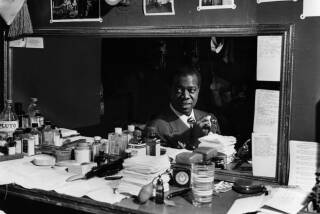Good Times With Two Masters
- Share via
What happens when two world-class jazz artists--dramatically similar in some respects, strikingly different in others--get together in the studio for a series of free and easy recording sessions? The answer is some extraordinary music, when the artists are vibraphonist Lionel Hampton and pianist Oscar Peterson. And Verve has chronicled a remarkable series of encounters between the two in a beautifully conceived and packaged 4-CD boxed set, “The Complete Lionel Hampton Quartets and Quintets With Oscar Peterson on Verve” (****).
Recorded in 1953-54, the sessions reveal some clear similarities between the two. At the time, each was a driving, hard-swinging improviser with masterful technique and complete harmonic mastery of anything he chose to play. In addition, each was--and is--a grunter, resulting in a counterpoint of monotonal humming to accompany their solos.
But there were differences as well. Hampton, a generation older than Peterson, came of age in the swing era, and his approach to rhythm is deeply rooted in the center of the beat. Although Peterson cannot be described as a pure bebop player, his sense of time is more flowing, more suspended above the rhythm, using it as propulsion rather than as the focus of his line. Interestingly, this contrast is also reflected in the rhythm team of bassist Ray Brown and drummer Buddy Rich. Brown’s walking bass has the lift of the bebop style, while Rich’s drumming--for all its virtuosity--is straight out of the big swing band style. And it is fascinating to note the contrast with the Modern Jazz Quartet, forming around the same time with the same instrumentation, but with a dramatically different approach to rhythm.
Hampton and Peterson are joined by clarinetist Buddy DeFranco--another player suspended between bebop and swing--on eight tracks, and by guitarist Herb Ellis on a number of others. And somehow, probably because of the sheer quantity of talent involved, all these players, with their sometimes disparate approaches, manage to come together to produce consistently entertaining, irresistibly swinging music.
The tunes, obviously chosen spontaneously at the sessions, include a large collection of standards--”Love for Sale,” “Always,” “Stardust,” “How High the Moon”--as well as a number of jazz items, including “Air Mail Special” and, featuring DeFranco playing with tremendous energy, a 17-minute romp through Hampton’s classic “Flying Home” (also present in a trio version). There are, in addition, such off-the-wall items as the theme from “The High and the Mighty,” “It’s a Blue World” (a hit in 1952 for the Four Freshmen) and a camp rendering of “When the Saints Go Marching In” (with vocal by Brown and the band).
ANOTHER LOOK BACK: The traditional jazz mainstream is often overlooked in the rush to chronicle and re-chronicle post-World War II jazz. Mosaic, the limited-edition company specializing in offbeat packages, has just released “The Complete H.R.S. Sessions” (*** 1/2), a six-CD collection of some stunning swing-period playing. The Hot Record Society, a prewar collectors organization that issued a magazine and opened a New York record store, produced the sessions between 1938-47, showcasing virtual all-star lineups of swing-era players, including clarinetist Pee Wee Russell, cornetist Rex Stewart, trumpeters Buck Clayton and Joe Thomas, trombonists Jack Teagarden, Dicky Wells and Trummy Young, and pianists Jimmy Jones and Billy Taylor.
Among the many highlights is a rightfully famous 1940 session featuring the unusually instrumented quartet of soprano saxophonist Sidney Bechet, cornetist Muggsy Spanier, guitarist Carmen Mastren and bassist Wellman Braud. (Mosaic releases are available solely through Mosaic Records, 35 Melrose Place, Stamford, CT 06902. [203] 327-7111.)
*
Albums are rated on a scale of one star (poor) to four stars (excellent).
More to Read
The biggest entertainment stories
Get our big stories about Hollywood, film, television, music, arts, culture and more right in your inbox as soon as they publish.
You may occasionally receive promotional content from the Los Angeles Times.










